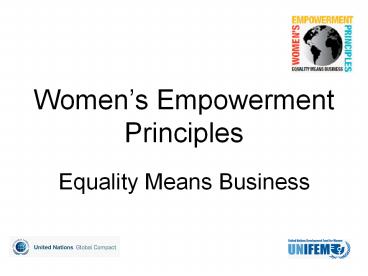Women - PowerPoint PPT Presentation
Title:
Women
Description:
Women s Empowerment Principles Equality Means Business Women s Empowerment Principles in Brief Establish high-level corporate leadership for gender equality. – PowerPoint PPT presentation
Number of Views:838
Avg rating:3.0/5.0
Title: Women
1
Womens Empowerment Principles
- Equality Means Business
2
- Womens Empowerment Principles in Brief
- Establish high-level corporate leadership for
gender equality. - Treat all women and men fairly at work respect
and support human rights and nondiscrimination. - Ensure the health, safety and well-being of all
women and men workers. - Promote education, training and professional
development for women. - Implement enterprise development, supply chain
and marketing practices that empower women. - Promote equality through community initiatives
and advocacy. - Measure and publicly report on progress to
achieve gender equality.
3
Principle 1 Leadership Promotes Gender Equality
- Affirm high-level support and direct top-level
policies for gender equality and human rights. - Establish company-wide goals and targets for
gender equality and include progress as a factor
in managers performance reviews. - Engage internal and external stakeholders in the
development of company policies, programmes and
implementation plans that advance equality. - Ensure that all policies are gender-sensitive
identifying factors that impact women and men
differently and that corporate culture advances
equality and inclusion.
4
Principle 2 Equal Opportunity, Inclusion and
Nondiscriminiation
- Pay equal remuneration, including benefits, for
work of equal value and strive to pay a living
wage to all women and men. - Ensure that workplace policies and practices are
free from gender-based discrimination. - Implement gender-sensitive recruitment and
retention practices and proactively recruit and
appoint women to managerial and executive
positions and to the corporate board of
directors. - Assure sufficient participation of women 30 or
greater in decision-making and governance at
all levels and across all business areas. - Offer flexible work options, leave and re-entry
opportunities to positions of equal pay and
status. - Support access to child and dependent care by
providing services, resources and information to
both women and men.
5
Principle 3 Health, Safety and Freedom from
Violence
- Taking into account differential impacts on women
and men, provide safe working conditions and
protection from exposure to hazardous materials
and disclose potential risks, including to
reproductive health. - Establish a zero-tolerance policy towards all
forms of violence at work, including verbal
and/or physical abuse, and prevent sexual
harassment. - Strive to offer health insurance or other needed
services including for survivors of domestic
violence and ensure equal access for all
employees. - Respect women and men workers rights to time off
for medical care and counseling for themselves
and their dependents. - In consultation with employees, identify and
address security issues, including the safety of
women traveling to and from work and on
company-related business. - Train security staff and managers to recognize
signs of violence against women and understand
laws and company policies on human trafficking,
labour and sexual exploitation.
6
Principle 4 Education and Training
- Invest in workplace policies and programmes that
open avenues for advancement of women at all
levels and across all business areas, and
encourage women to enter nontraditional job
fields. - Ensure equal access to all company-supported
education and training programmes, including
literacy classes, vocational and information
technology training. - Provide equal opportunities for formal and
informal networking and mentoring. - Offer opportunities to promote the business case
for womens empowerment and the positive impact
of inclusion for men as well as women.
7
Principle 5 Enterprise Development, Supply
Chain and Marketing Practices
- Expand business relationships with women-owned
enterprises, including small businesses, and
women entrepreneurs. - Support gender-sensitive solutions to credit and
lending barriers. - Ask business partners and peers to respect the
companys commitment to advancing equality and
inclusion. - Respect the dignity of women in all marketing and
other company materials. - Ensure that company products, services and
facilities are not used for human trafficking
and/or labour or sexual exploitation.
8
Principle 6 Community Leadership and Engagement
- Lead by example showcase company commitment to
gender equality and womens empowerment. - Leverage influence, alone or in partnership, to
advocate for gender equality and collaborate with
business partners, suppliers and community
leaders to promote inclusion. - Work with community stakeholders, officials and
others to eliminate discrimination and
exploitation and open opportunities for women and
girls. - Promote and recognize womens leadership in, and
contributions to, their communities and ensure
sufficient representation of women in any
community consultation. - Use philanthropy and grants programmes to support
company commitment to inclusion, equality and
human rights.
9
Principle 7 Transparency, Measuring and
Reporting
- Make public the company policies and
implementation plan for promoting gender
equality. - Establish benchmarks that quantify inclusion of
women at all levels. - Measure and report on progress, both internally
and externally, using data disaggregated by
gender. - Incorporate gender markers into ongoing reporting
obligations.
10
WEPs as a Tool
- Focusing on how to bring the private sector can
play in to promoting gender equality and women's
empowerment - Take them into account in developing and revising
public policies on gender equality and women's
empowerment and corporate responsibility - Use them when engaging in dialogue with the
private sector about their role - Consider corporate commitment the WEPs when
making decisions about which businesses to
partner with, procure from, or other such
economic decisions.
11
Materials and Resources
For more information, please visit
http//www.unglobalcompact.org/Issues/human_right
s/equality_means_business.html Or http//www.unife
m.org/partnerships/womens_empowerment_principles/
12
THANK YOU































